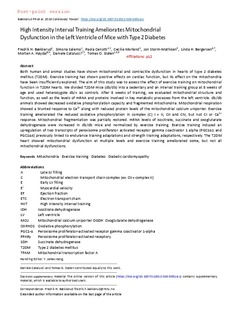| dc.contributor.author | Bækkerud, Fredrik Hjulstad | |
| dc.contributor.author | Salerno, Simona | |
| dc.contributor.author | Ceriotti, Paola | |
| dc.contributor.author | Morland, Cecilie | |
| dc.contributor.author | Storm-Mathisen, Jon | |
| dc.contributor.author | Bergersen, Linda Hildegard | |
| dc.contributor.author | Høydal, Morten | |
| dc.contributor.author | Catalucci, Daniele | |
| dc.contributor.author | Stølen, Tomas | |
| dc.date.accessioned | 2020-03-09T12:02:21Z | |
| dc.date.available | 2020-03-09T12:02:21Z | |
| dc.date.created | 2019-12-30T12:48:12Z | |
| dc.date.issued | 2019 | |
| dc.identifier.citation | Cardiovascular Toxicology. 2019, 19 (5), 422-431. | nb_NO |
| dc.identifier.issn | 1530-7905 | |
| dc.identifier.uri | http://hdl.handle.net/11250/2646000 | |
| dc.description.abstract | UNIKARD (Project Number 217777/H10) | nb_NO |
| dc.description.abstract | Both human and animal studies have shown mitochondrial and contractile dysfunction in hearts of type 2 diabetes mellitus (T2DM). Exercise training has shown positive effects on cardiac function, but its effect on the mitochondria have been insufficiently explored. The aim of this study was to assess the effect of exercise training on mitochondrial function in T2DM hearts. We divided T2DM mice (db/db) into a sedentary and an interval training group at 8 weeks of age and used heterozygote db/+ as controls. After 8 weeks of training, we evaluated mitochondrial structure and function, as well as the levels of mRNA and proteins involved in key metabolic processes from the left ventricle. db/db animals showed decreased oxidative phosphorylation capacity and fragmented mitochondria. Mitochondrial respiration showed a blunted response to Ca2+ along with reduced protein levels of the mitochondrial calcium uniporter. Exercise training ameliorated the reduced oxidative phosphorylation in complex (C) I + II, CII and CIV, but not CI or Ca2+ response. Mitochondrial fragmentation was partially restored. mRNA levels of isocitrate, succinate and oxoglutarate dehydrogenase were increased in db/db mice and normalized by exercise training. Exercise training induced an upregulation of two transcripts of peroxisome proliferator activated receptor gamma coactivator 1 alpha (PGC1α1 and PGC1α4) previously linked to endurance training adaptations and strength training adaptations, respectively. The T2DM heart showed mitochondrial dysfunction at multiple levels and exercise training ameliorated some, but not all mitochondrial dysfunctions. | nb_NO |
| dc.language.iso | eng | nb_NO |
| dc.publisher | Humana Press | nb_NO |
| dc.title | High intensity interval training ameliorates mitochondrial dysfunction in the left ventricle of mice with type 2 diabetes | nb_NO |
| dc.type | Journal article | nb_NO |
| dc.type | Peer reviewed | nb_NO |
| dc.description.version | acceptedVersion | nb_NO |
| dc.source.pagenumber | 422-431 | nb_NO |
| dc.source.volume | 19 | nb_NO |
| dc.source.journal | Cardiovascular Toxicology | nb_NO |
| dc.source.issue | 5 | nb_NO |
| dc.identifier.doi | 10.1007/s12012-019-09514-z | |
| dc.identifier.cristin | 1764362 | |
| dc.relation.project | Samarbeidsorganet mellom Helse Midt-Norge og NTNU: Project Number 90158300 | nb_NO |
| dc.relation.project | Norges forskningsråd: FRIPRO Project Number 214458 | nb_NO |
| dc.relation.project | Norges forskningsråd: Young Outstanding Investigators Project Number 231764 | nb_NO |
| dc.description.localcode | This is a post-peer-review, pre-copyedit version of an article. Locked until 29.3.2020 due to copyright restrictions. The final authenticated version is available online at: https://doi.org/10.1007/s12012-019-09514-z | nb_NO |
| cristin.unitcode | 194,65,25,0 | |
| cristin.unitcode | 1920,6,0,0 | |
| cristin.unitcode | 194,65,15,0 | |
| cristin.unitname | Institutt for sirkulasjon og bildediagnostikk | |
| cristin.unitname | Klinikk for hjertemedisin | |
| cristin.unitname | Institutt for klinisk og molekylær medisin | |
| cristin.ispublished | true | |
| cristin.fulltext | original | |
| cristin.fulltext | postprint | |
| cristin.qualitycode | 1 | |
